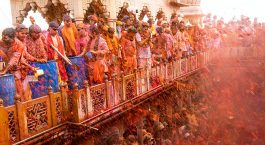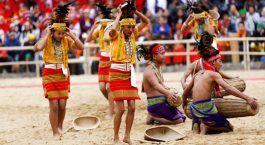What’s better than partaking in the popular winter festivals in India in winter to bid adieu to the year on a meaningful note? Unlimited fun, frolic, merrymaking, and an eclectic way of celebrating an occasion, famous winter festivals in India are nothing but a potpourri of all these.
From Pushkar Fair to Diwali and from Lohri to Sunburn Festival, each of them is distinctive and presents different cultures of India distinctively.
Although the country celebrates umpteen fiestas throughout the year, the festival celebrated in the winter season lures scores of tourists. Here are some of the galas that will urge you to pack your bags and plan a trip to India soon.
25 Popular Festivals in India in Winter
- Lohri
- Pongal
- Ram Mahotsav
- Makar Sankranti and the Gujarat Kite Festival
- Pushkar Camel Fair
- Diwali
- Christmas
- Chhath Puja
- Navratri
- Jaisalmer Desert Festival
- Bikaner Camel Festival
- Nagaur Festival
- The Goa Carnival
- Rajasthan International Folk Festival (RIFF)
- Mount Abu Winter Festival
- Elephant Festival (Rajasthan)
- Ganga Mahotsav
- Republic Day
- Holi
- Sunburn Festival
- Ziro Festival
- Hornbill Festival
- Winter Carnival
- Konark Dance Festival
- Bihu Magh
Lohri – a winter crop season celebration

A harvest festival, Lohri marks the end of the winter season and is also a time to thank the Sun God for a good harvest. Many interesting legends are associated with this popular winter festival in India which makes the fiesta more exciting.
During the Lohri celebration, Punjab becomes alive and is decorated like a new bride. You may hear the folklores of Dulla Bhatti and as the dusk falls down, you will find people eagerly awaiting to cherish the moment.
When it is celebrated – 13th January
Where it is celebrated – Mainly in Punjab and Haryana. However, some other parts of North India have also started partaking in the gala.
How it is celebrated – The highlight of Lohri is the bonfire. In the morning, children go to the nearby houses to ask for some donation for the bonfire. Various tricks are used to urge people to give generously. Returning the children empty-handed is considered inauspicious.
Thus, people give them sweets, money, jaggery, til, etc. In the evening, people dress up in traditional attire gather near the sacred fire (Lohri Goddess) and perform folk dances.
Offerings are made to the Fire Goddess and then the same is distributed amongst the near and dear ones. Lohri is of special importance for the newborns and the newly-wedded couples. The feast consists of Makki ki roti and Sarson ka saag.
Pongal – thanksgiving ceremony for the good harvest

Celebrated for 4 days, Pongal is one of the popular winter festivals in South India. The first day is for the lord of fire; the second day is for the Sun God, third for the cattle and fourth is for the birds.
Dating back to the time of Puranas and Indo-Aryan era, Pongal is a significant celebration in India. Besides observing people offering gratitude to the Lord Sun and Rain God for good harvest, one can also become a part of unlimited dancing, and music, and savor several traditional cuisines.
When it is celebrated – 14th January – 17th January
Where it is celebrated – Tamil Nadu, Puducherry and Sri Lanka
How it is celebrated – Women in the southern part of the country cook Pongal, a dish made up of first rice of the season. This is then consumed on this day after offering it to the Sun God.
Cooking is done in sunlight in a courtyard and that too in a clay pot adorned with colored patterns. Bhogi is the day before Pongal. On this day, people remove old possessions and cherish the new ones. The discards are burned in a bonfire lit in the evening.
The second day is marked as the Thai Pongal. Pongal is cooked and is served to everyone along with other eatables. Mattu Pongal falls on the third day when cattle are revered and offered various things affectionately.
Games like the Taming bull and Jallikkattu leave the onlookers mesmerized. Reunions are held on the fourth day of Pongal known as Kaanum Pongal.
Rann Mahotsav – celebrate the warmth and spirit of people of Kutch
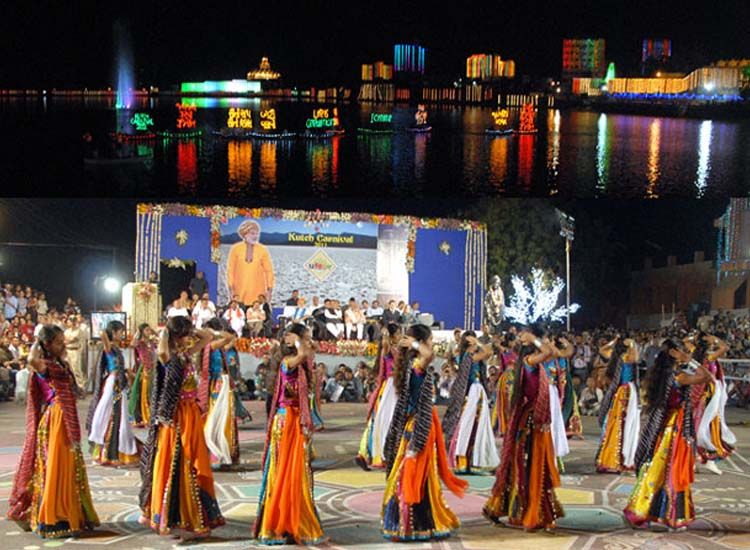
The Rann Mahotsav takes place on the salt marsh in the western province of the country which is also one of the world’s largest salt desert. The three months fair bustles with stark vivacity; the white salt strewn all around complements the color of Gujarat’s ethnicity.
People come here from every corner of the world to shop for bandhani sarees, Gujarati handlooms and what not. And when they are not shopping, the cultural programs, which reflect the life of the state, are savored. Adding on to this experience are heritage walks and wildlife sanctuaries of Gujarat.
When it is celebrated – November onwards
Where it is celebrated – The Great Rann of Kutch
How it is celebrated – The fiesta is a carnival of music, dance, and culture. Many activities are hosted during the festival like cultural acts, dance shows, camel safari, musical shows, etc.
A tent city is specially built over a vast area for the occasion. After the ardent efforts of the people for two months, the temporary city gets ready to welcome tourists from all over the world.
More than 350 hospitality personnel are appointed to work at different levels and make the fete memorable. Full-moon nights in winter raise the fun quotient.
Makar Sankranti and the Gujarat Kite Festival

Makar Sankranti is another harvest fiesta that has marked its entry on the list of popular festivals in India in winter. Grand fairs are conducted to highlight the synchronization of the lunar and solar calendars.
Innumerable devotees take a holy dip in the River Ganges and give alms to the needy. From this day onwards, winter starts to end and longer days are observed.
Famed for being celebrated in different cultural forms, the festival outstands amongst the rest as the Gujarat Kite Festival. During the festival, several kites of various shapes and sizes are flown in the sky.
When it is celebrated – 14th January
Where it is celebrated – North India and many other parts of the country
How it is celebrated – The festival starts with taking a holy dip in the River Ganges. Thereafter, people donate things to the poor in the form of rice, pulses, ghee, money, clothes, etc.
Further, khichdi is made and served to the family members. Sweets are given to neighbors and relatives.
‘Til’ aka sesame and ‘Gud’ aka jaggery is offered and it is expected the year ahead will be full of happiness and sweet moments to be enjoyed.
Children in rural areas go door to door and ask for treats while singing folk songs. Dances, bonfires, feasts, and kite flying competitions complete the day.
Pushkar Camel Fair – to admire the true spirit of India
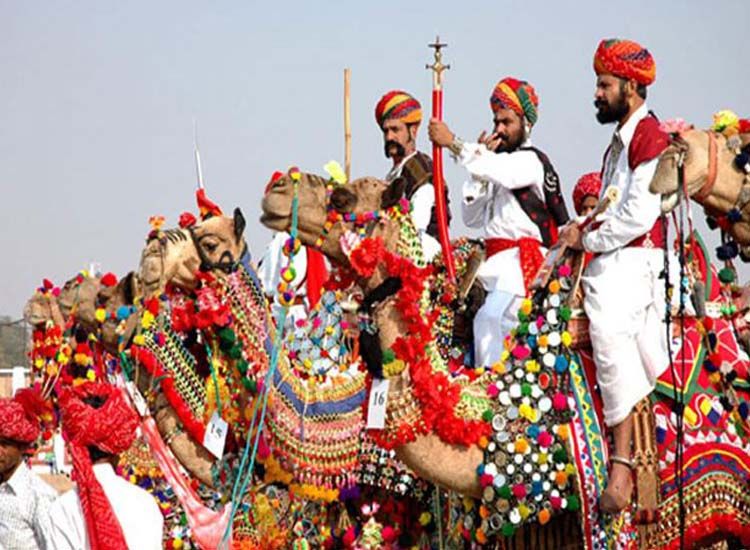
There is nothing better than attending the Pushkar Camel Fair to start the winter season delightfully. The fair enchants millions of tourists and is the largest horse, camel, and cattle fair.
The annual multi-day cultural fete and livestock fair is one of the best festivals in India in winter and presents a matchless sight to behold.
It is also believed that during this time all the Gods and Goddess come to Earth to take a holy dip in the sacred Pushkar Lake. Thus, devotees do not skip a chance to do the same and wash away their sins.
A number of competitions are hosted and umpteen camels are brought to the fiesta. Besides the buying and selling of the cattle, traditional handicrafts are also put on display.
When it is celebrated – From Kartik Shukla Ekadashi to Kartik Purnima (usually falls during late October and early November).
Where it is celebrated – Pushkar
How it is celebrated – People gather around the sacred Pushkar Lake. After taking a holy dip they enjoy participating in various competitions which include turban tying, tug of war, matka phod, longest mustaches, dances, camel race, bridal competition, etc. Trade of cattle goes on for the entire day.
People spend lots of time shopping for handicrafts etc. This all is accompanied by folk songs and traditional dances. In the meanwhile, the cattle are washed, cleaned, scrubbed, and beautifully decorated with jewelry and clothes and are then bought and sold.
Diwali – marking the victory of good over the bad
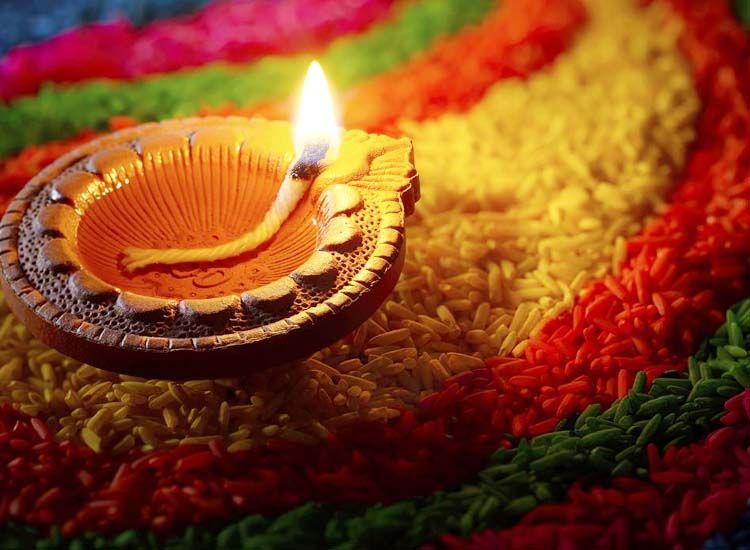
Fondly referred to as the festival of lights, Diwali has many legends associated with it. The day holds great importance to Hindus but interestingly every other religion in this diverse country observes Diwali with equal vehemence.
People all around the country eagerly await the major fiesta and thus it is one of the most famous festivals in the winter season in India. Lightning of diyas, sharing sweets, decorating houses, and most importantly worshipping Goddess Lakshmi and Lord Ganesh are the major highlights of the festival.
When it is celebrated – The darkest night of the Hindu Lunisolar month Kartika which falls between mid-October and mid-November
Where it is celebrated – Throughout India and some other parts of the world as well
How it is celebrated – The celebration of the Diwali festival lasts for five days. The first day is marked as the Dhanteras. People clean their houses and decorate it to welcome Goddess Lakshmi (Goddess of wealth and prosperity) and buy gold ornaments. A few people play cards as well on this day. Lord Dhanvantari (the Hindu God of medicines) is also revered on this day.
The second day is known as the Choti Diwali. On this day, Diwali is celebrated on a small scale. Houses are thoroughly cleaned and rangolis are made outside.
The third day is observed as Diwali. In the morning, people dress up in new attire and go to their respective places of work to offer prayers and worship. They, then visit their relatives to offer sweets and exchange gifts.
In the evening, a clean dress is worn and people worship Goddess Lakshmi and Lord Ganesh. Since the Hindu goddess loves cleanliness and visits the cleanest house first, it is a ritual to worship the broom as well. Crackers are burst and wishes are passed on.
The day post-Diwali is celebrated as Govardhan Pooja to pay homage to a small hillock near Mathura. The final day is cherished as Bhai Dooj when the bond between brother and sister is admired.
Christmas – commemorating the birth of Lord Jesus

Christmas is a cultural extravaganza that includes endless fun. This festival of the winter season in India offers opportunities to savor delicious cakes, Christmas pudding, and scrumptious dishes including finger-licking turkey.
Although it is an important festival for Christians the integrity in the diversity of India makes it popular amongst all religions.
Christian people share sweets and cakes with neighbors and friends. Santa Clause is eagerly awaited to hike the festive spirits, especially in small kids.
People decorate Christmas trees and adorn houses with Christmas themes. Parties are hosted which mark the end of another legendary year.
When it is celebrated – 25th December
Where it is celebrated – Especially in Southern India and some other parts of the world as well
How it is celebrated – Festivities for Christmas begin by mounting a Christmas tree in the house and adorning it. It is festooned with lights and many other decorating items.
Christmas stockings are hung by the children, expecting Santa to come and secretly place a gift in them.
Christmas carols are sung and stories about Jesus, Mother Mary, Santa Claus, etc. are narrated by the parents. People visit churches and offer prayers.
They also wish each other, cut cakes, conduct parties, and exchange gifts. Fasts are observed and special religious observances like midnight mass are hosted.
Chhath Puja – honoring Sun God for bestowing the Earth with an abundance of life
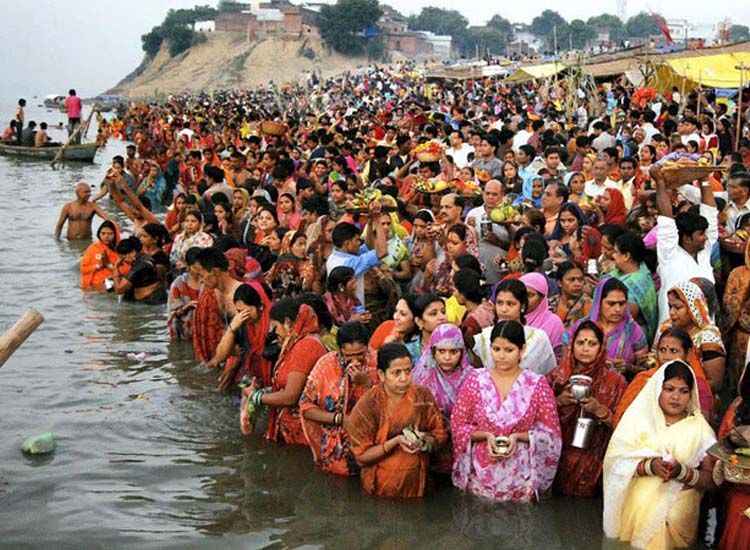
Chhath puja is dedicated to the Sun. Worshipping the Sun is considered sanctifying in the Hindu religion and thus, they call him ‘Surya Devta’. During Chhath, prayers are offered to Sun to thank him for the existence of life on earth. It is also believed that on this day if someone gets involved in the puja his wishes get granted by the lord.
The fiesta finds are mentioned in the Rig Veda and it is quite apparent that it is being celebrated as a winter festival in India since then. Interestingly, all the rituals associated with the festival represent a scientific process for reviving and detoxification of the body.
When it is celebrated – The 6th day of the Hindu lunar month of Kartik
Where it is celebrated – Bihar and Uttar Pradesh
How it is celebrated – The four-day fiesta begins with Nahay Khay. It is the day when people take a dip in holy rivers and take home the sacred water to prepare offerings.
The second day is Lohanda when devotees observe a fast for the whole day and end it in the evening by paying homage to the Sun and the Moon.
After cooking and consuming the food, they again start fasting for 36 hours, without even drinking water. On the third day of Sandhya Arghya, followers take a dip in the holy water in the evening and pray to the Sun and the Chhathi Maiya.
On the last day, Usha Arghya starts with morning offerings to the Sun which completes the fast and the merriments.
Navratri – paying homage to the nine forms of Goddess Durga

Nav means “nine” and Ratri means “night”, therefore, Navratri is a festival of nine nights. During these nine nights, nine forms of Maa Durga (Hindu goddess) are celebrated with indestructible faith. Hindus fast during this period of time and open their fast on the eighth or ninth day (depending on region to region).
9 girls of the age ranging from a few days to 12 years are invited to eat at peoples’ houses and bestow prosperity on them. The tenth day of the Shardiya Navratri is called “Dussehra” and is celebrated in myriad ways. Usually, there are four seasonal Navratri, however, only two of them, are celebrated on a large scale.
When it is celebrated – Chaitra Navaratri occurs in the month of March or April whereas Shardiya Navratri falls in the month of September or October
Where it is celebrated – North India, especially in Gujarat and other parts of the country
How it is celebrated – Navratri is celebrated in different ways in different areas. However, some common rituals include praying to the nine manifestations of Goddess Durga during the nine days. Fasting is observed during these days. Onion and garlic are strictly prohibited. The idols of Goddesses are beautifully decorated and worshiped.
On the very first day devotees, after bathing, wear clean clothes and place a Kalash at their place of worship.
A few of them sow a few grains of barley and take care of them for nine days which epitomizes a good crop and blessing of prosperity in the family. After offering the prayers for nine days, the fasting ends with inviting nine girls to the home and offering them food.
Jaisalmer Desert Festival – to soak in the traditional culture of Rajasthan
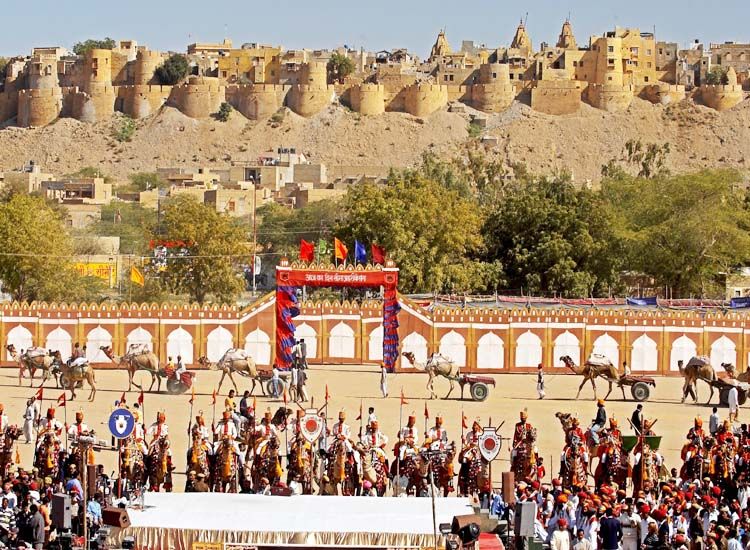
The ostentatious colors of Rajasthan will rise your spirits and its best example is Jaisalmer Desert Festival. The three-day fair which is held in Jaisalmer and flaunts the cultural exuberance of the state. The country takes pride in this famous winter festival in Rajasthan and does not miss a single chance to be a part of the exciting gala.
People perform folk dances wearing colorful traditional attires and tap into the tunes of Rajasthani folk music that is being played in the background. Not just that! There are snake charmers and puppeteers alluring the crowd with the shows.
Turbans and mustaches are Rajasthan’s cultural signature and these two attributes are not overlooked ever. The people with glorious mustaches and the ability to tie turbans in a flash of time enter the competition which raises the fun quotient.
When it is celebrated – February
Where it is celebrated – Jaisalmer
How it is celebrated – As the Jaisalmer Desert Festival begins, everything gets a new life. Hoards of people get enchanted by the gala. Performers present their talent.
Fire dance grabs the attention. Cultural events are held. One can expect meticulously created handicrafts, exciting competitions, savory cuisines and so much more.
Breathtaking sunset views are always an added plus. A desert safari to Sam sands dunes and live performances under the star-lit sky marks the end of the festival. Witnessing the most beautiful fireworks in the sky is another highlight of the festival.
Bikaner Camel Festival – honoring Camels, the ships of the desert
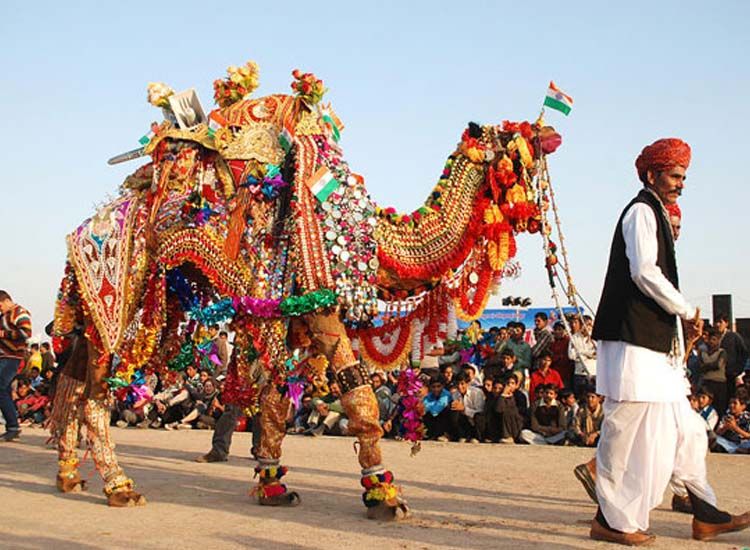
Camel festival in Bikaner is a colorful and lively event. One of the well-known winter festivals in India is celebrated to venerate the camels of the city who are famed for their strength and beauty. The valor of the camels here is such that the Bikaner army is proud of its elite camel corps which actively participated in both world wars.
Visitors are rendered speechless after witnessing the Rajasthani traditional folk dance performances which increase the charm of this festival. A striking display of the camels adorned with heavy jewelry and showing excellent footwork on the golden dunes beguiles the onlookers.
When it is celebrated – January
Where it is celebrated – Bikaner
How it is celebrated – The parade of the beautifully adorned camels marks the beginning of the festival which presents a sight to behold. Activities like camel races, camel milking, camel acrobatics, fur cutting designs, and the best breed steal the limelight. Photography, eating, shopping, and cultural performances keep the guests engaged.
With the Junagarh Fort in the backdrop, the activities like skirt swirling dances, fire dancing, and firework seem so magical.
The fortified city gets a new life when craftsmen and traders from all around India come to participate in the cultural fete. Tea made from camel milk removes all the weariness of the day.
Nagaur Festival – second biggest cattle fair in India
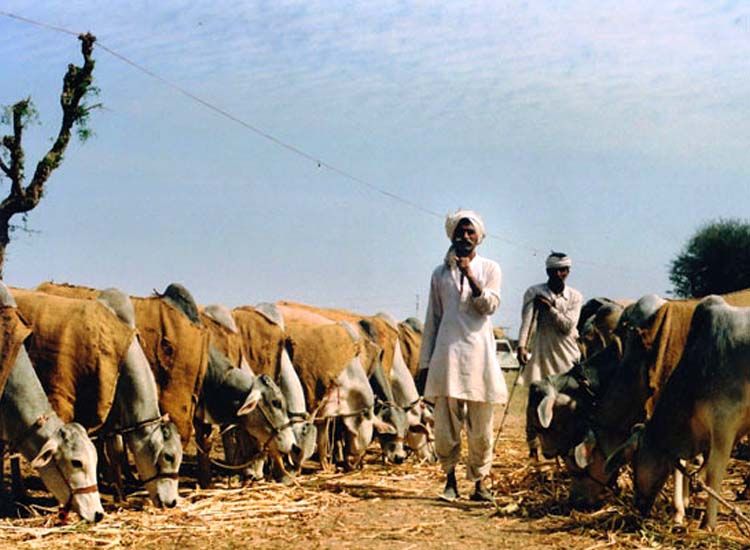
Nagaur festival is solely dedicated to the cattle, where people sell and buy them and treat them as guest of honor. This makes the festival the second largest cattle fair in India. The two-day event is attended by more than one lakh people.
Camel races, bullock races, tug-of-war, and many other amusing competitions are organized and participated with high festive spirits.
The Mirchi Bazaar is bustled with travelers who love the traditional folk of the state and buy ethnic costumes, neckpieces, handicrafts, and whatnot. The festive spirit is palpable and beyond description. Storytellers, puppet shows, and the Sufi festival cast a spell on the visitors.
When it is celebrated – January or February
Where it is celebrated – Nagaur
How it is celebrated – The Nagaur festival begins with the arrival of many traders and participants from all around India. Cattle are decorated and exhibited.
Trading of cattle continues for the day. As the sun bids farewell to the day, the ground transforms into an open theater with several activities amusing the visitors.
[Read more about Nagaur Festival]
The Goa Carnival – a precursor to the abstinence of Lent

Being celebrated since the 18th century, the Goa Carnival is the largest carnival festival in India. Introduced by the Portuguese, the carnival fills the city with huge vibrant parades, merrymaking people, tableaus, floats, and whatnot!
Earlier, this festival of the winter season was only cherished by the natives but now it has managed to attract the international crowd as well. Live music bands, dance, food, etc. account for making the festival of revelry a unique spectacle.
The spark of effervescence can be felt in the air and seen in the streets from December only. Imagine the intensity of vibrancy during those three days! Everything is so colorful and joyous that this makes up for all the gloom in your life.
When it is celebrated – February/March
Where it is celebrated – Goa
How it is celebrated – King Momo presides over the festival and on the first day, orders his subjects to eat, drink, and party. This is marked by a float parade in Panaji which is led by a special float hosted by King Momo. Huge colorful parades take over the state’s cities with bands, floats, and dances.
The evenings are reserved for unlimited partying wherever you are. The final day’s festivities are ended with the famous red-and-black dance held by the Clube Nacional in Panjim.
Rajasthan International Folk Festival (RIFF) – promoting traditional folk music and arts
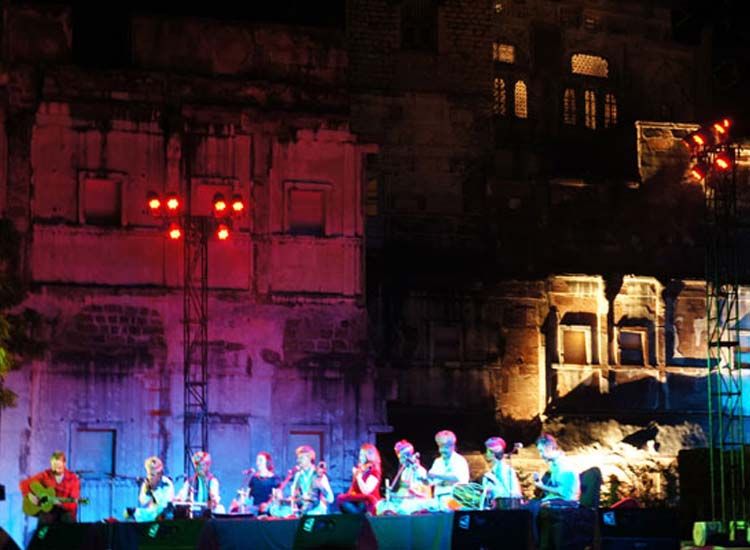
The Rajasthan International Folk Festival adds up to the glory of the already well-known Mehrangarh Fort. Supported by UNESCO, the festival is leading the charts since its inception.
Anticipated by even the top-notch musicians, the gala leaves a deep impact on everybody present there through some of the highly sensational performances. A fusion of International and Indian music takes the swarm of music lovers into an entirely new world of melodies.
The five-day winter festivals in India is a constant, flawless, and graceful display of the essence of Rajasthani folk through music, dance, art forms, and everything. Especially at night, the lights are sparkling and dreamy.
When it is celebrated – Sharad Purnima, usually in October or November
Where it is celebrated – Mehrangarh Fort, Jodhpur
How it is celebrated – The magic of RIFF begins in the evening when the full moon shines brightly. A series of musical concerts and spectacular events are hosted as the sun signs off for the day.
Traditional Rajasthani programs entertain the visitors. Some of the excerpts from the main stage performances are also enacted. Drummers and dancers conclude the fiesta with a rousing finale.
Mount Abu Winter Festival – to revel in the cheerfulness and happiness among the natives
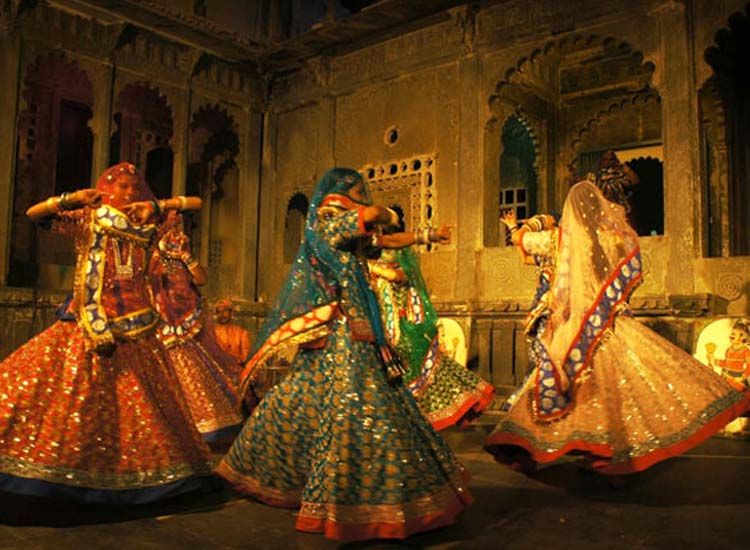
A tribute to the intriguing customs and culture of Rajasthan, the Mount Abu Winter Festival is a perfect way to break the monotony of hectic life. Held at the only hill station of Rajasthan, this three-day fest flaunts the sparkling Rajasthan and also of other states of India.
The festivals related to seasons in India are a must-attend to get acquainted with the very essence of the cultural diversity of this country. People gather at Nakki Lake Chowk. Amidst the soulful views of the hills, cultural performances from Gujarat, Punjab, Haryana, and other states are carried out.
When it is celebrated – December
Where it is celebrated – Mount Abu
How it is celebrated – Offering lots of room for fun and frolic, the fiesta pampers you with world-class hospitality. Numerous performances by the artists make the event a huge success. The festival is also known to conduct sports events as well. Interestingly, cricket matches are also organized.
Many diyas are lighted on Nakki Lake and this is called the ‘Deepdaan’. Besides this people indulge in air ballooning, Gilli danda, cricket, kite flying, and everything that makes them believe that sheer ecstasy is not just in fairy tales.
[Read more about Mount Abu Winter Fesival]
Elephant Festival (Rajasthan)
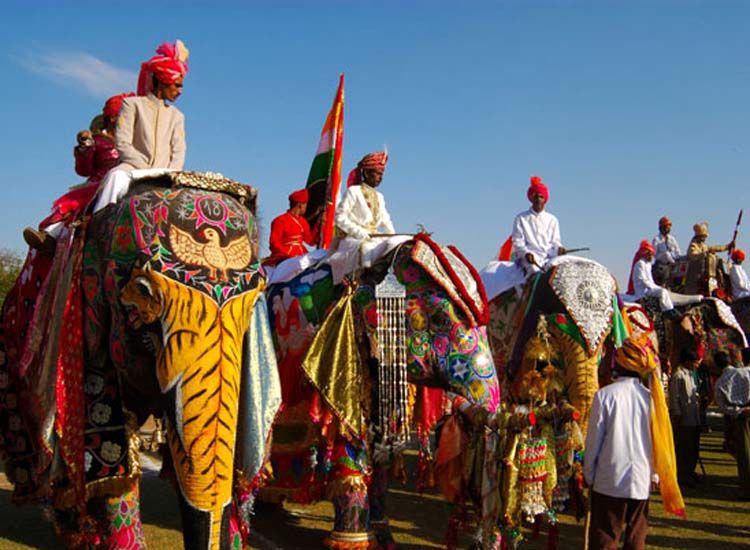
Imagine watching over the female elephants wearing beautiful trinkets which make noise as they move. The elephant festival is replete with such kinds of sights and sounds.
A stunning procession of camels, elephants, folk dancers, and horses is a major drawcard of the fiesta. The festival mainly involves owners decorating their elephants beautifully.
The most attractively adorned elephant is awarded. People sprinkle gulaal on the ones sitting on top of the elephant. Caretakers of elephants embellish the forehead of elephants with head-plates and their tusks with bracelets and rings of gold and silver.
When it is celebrated – On Holi, usually in March
Where it is celebrated – Jaipur
How it is celebrated – Just like in the camel festival, owners embellish their elephants by painting them with bright colors, putting heavy ornaments and schools to make them look the best. The elephants enter the ground with their caretakers amidst the loud sounds of drums and nagadas.
There are competitions like a tug-of-war between the elephants, elephants dance, elephant polo, and much more to celebrate this enchanting day. The festival is way more interesting than it sounds.
Ganga Mahotsav – to honor the goddess of the holy river
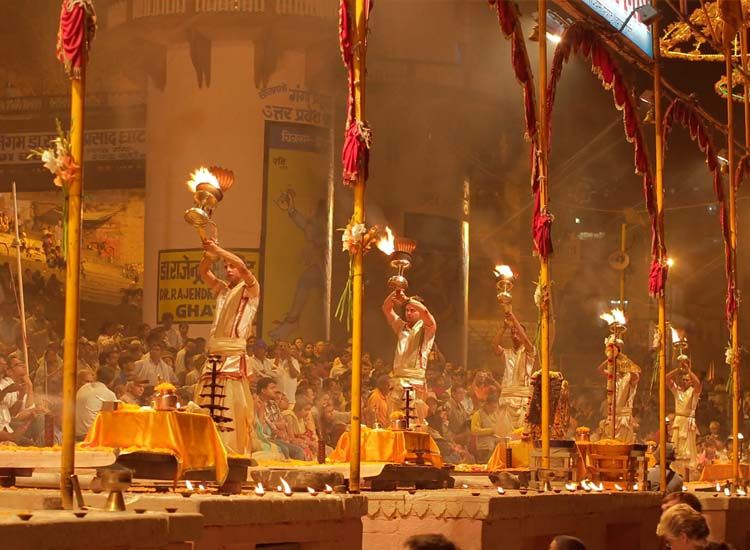
The sanctity of the holy river Ganga is known in every corner of the world. Attending Ganga Aarti at Varanasi remains on the wish list of many planning a tour to India. The Ganga Mahotsav indeed celebrates Goddess Ganga’s purity by mass offering soulful prayers.
Besides this there are music and dance performances, country boat races, and other games to keep the festival appealing. A lot of things can be shopped for which not only display India’s culture but also its simplicity.
Ganga Mahotsav remains on the list of winter festivals as it provides a platform that draws India’s culture and finest crafts to a single place.
When it is celebrated – from ‘Prabodhini Ekadashi’ till Kartik Poornima usually in October or November
Where it is celebrated – Varanasi
How it is celebrated – During the festival, a wide range of crafts, arts, and cuisines are exhibited. Many sports completion like the Ganga marathon, kite flying, boating, and wrestling hike the fun factor.
On the last day out of the five, the festival coincides with Dev Deepawali, when, needless to say, every corner sparkles with bright lights. Thousands of diyas are lit along the banks of river Ganga providing it a majestic look.
Chanting of Vedic hymns enhances the spiritual aura. All this is done to welcome the Hindu deities which descend on this day on Earth to take a holy dip in the river. The Gandhi Shilp Bazaar will surely tempt you to shop till you drop.
[ Read more with Varanasi Travel Guide or explore packages ]
Republic Day – a day when the Indian constitution came into effect

India, on its Republic Day, celebrates the day when its constitution came into force in 1950. The day is celebrated with a zeal of patriotism around all the corners of the country, especially in Delhi. Major highlights of the festival are savored at Rajpath, Delhi where different states flaunt their culture in a beautiful state-wise jhaanki (tableau) during the parade.
People around the country watch its live telecast on television. Just after the show, Delhiites move out to their terraces and wave to the fighter jets which fill the sky with their thundering sound, presenting summersaults and making the tri-color flag.
When it is celebrated – 26th January
Where it is celebrated – All around the country, especially in Delhi
How it is celebrated – The Prime Minister lays a floral wreath at the Amar Jawan Jyoti just before the commencement of the Republic Day parade. Subsequently, a two-minute silence is observed in the memory of the brave Indian soldiers who lost their lives fighting for the country.
Post this, PM reaches the Rajpath where he is joined by other dignitaries. President marks his arrival along with the chief guests thereafter.
The national flag is hoisted by the President, National Anthem is played and National Salute is rendered. Important awards like Ashok Chakra are bestowed soon after. Children who are conferred with the National bravery award ride past the audience.
There is a march past by the Indian army and various troops. Later on, tableaus of different states and departments make their way on the Rajpath. School children actively participate in the parade and present cultural programs.
Professional drivers of the army perform stunts on the bike and render everyone speechless. Indian Navy presents a unique spectacle in the sky. The Republic day festivities are ended with the beating retreat ceremony after the third day of the event.
[Read more about Republic Day]
Holi – marking the victory of good over evil and the arrival of spring

Nothing comes close to the liveliness and enthusiasm that Holi, the festival of colors, brings along with it. Everywhere you can see people smearing each other with ‘gulaal’, savoring ‘gujiya’, sipping on the ‘thandai’, and dancing to the peppy songs.
Balloons filled with colorful water are thrown over the people and the joy of the fiesta is apparent from the way they hug each other. India is renowned worldwide for its ‘Braj ki Holi’ which takes the excitement of this popular winter festival to a whole new level.
When it is celebrated – Full Moon Day in the month of Falgun, usually in March
Where it is celebrated – All over India
How it is celebrated – Merriments of Holi commence an evening before the actual festival. People gather around a bonfire which is considered to be pious. They pay their homage in various ways and worship the bonfire before and after it is lit.
Women rotate around the fire and pray for the good health and prosperity of their families. It is a ritual to place a thick roti with a thread around it into the fire.
Once the ashes remain the roti is removed and it is nothing less than a miracle to see that the roti burns but not the thread. The roti here signifies Holika, sister of a demon and the thread symbolizes Prahalad, an ardent devotee of Lord Vishnu.
The whole process thus marks the victory of good over the bad. This roti is then consumed as Prasad. The next morning, people take the ashes of the bonfire and apply them to their bodies for purification. Thereafter, unlimited fun and frolic begin with cuisines, colors, gulaal, and what not!
Sunburn Festival – cherishing music at Pune

Get ready to enjoy an eclectic mix of entertainment, music, dance, celebration, and experiences at the Sunburn Festival. After enthralling the audience at the Vagator Beach in Goa for years, India’s biggest Electronic Dance Music festival has been shifted to Pune.
But still, the craze for this famous winter season festival in India is so high that nearly 3, 50,000 people attend the musical gala. The spectacular fiesta features performances by some of the renowned names in this field. Lighting, staging, and pyrotechnics prove to be head-turners during the festival.
When it is celebrated – December
Where it is celebrated – Pune
How it is celebrated – Ranked as one of the top 10 festivals in the world, the Sunburn is a perfect amalgamation of entertainment, food, music, and shopping.
The 4-day musical extravaganza has multiple stages with artists performing simultaneously. People eagerly await the festival and show extreme enthusiasm for attending it.
Ziro Festival – depicting the independent music scene in India

With the commencement of the Ziro festival, the picturesque valley of Arunachal Pradesh starts to reverberate with musical beats. The fiesta is a one-of-its-kind celebration that can evoke love for music like no other popular winter festivals in India.
Suggested to Read: Best time to visit Ziro
The gala also receives participation from several international and national bands. You will be amused to witness a unique yet entertaining combination of soulful music amidst the pristine mountains.
Also Read: Things to do in Ziro
Offering you numerous opportunities to connect with yourself, the event is a must-attend at least once in a lifetime. The journey to the venue of the festival is as intriguing as the event itself.
When it is celebrated – September
Where it is celebrated – Ziro Valley
How it is celebrated – The Ziro Festival takes place away from the maddening rush. Music takes the center stage and spectacular views soothe the soul. The festival offers a perfect platform for the musicians to showcase their talent and please the crowd with original music. The Apatani people of Ziro host these three days festivals.
Visitors are served the local beer in bamboo glasses which steals the limelight. North Indian delicacies are an added plus. In the end, the gala leaves you with thousands of reasons to be a part of it next time as well.
Hornbill Festival – to promote the cultural heritage of Nagaland
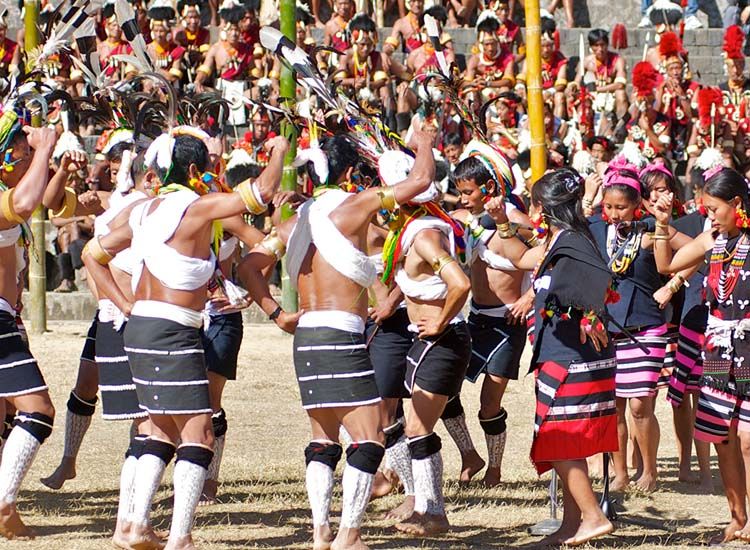
Named after the Indian Hornbill, a colorful and large forest bird, the Hornbill festival portrays a fusion of cultural displays in a single place.
Incepted with the aim of promoting tourism, the fiesta presents Nagaland like never before. Home to various tribes, the state cherishes many festivals that revolve around agriculture and are considered sacred.
Thus, it becomes mandatory to partake in these fiestas. The musical tunes during the performances seem euphonious and hypnotize the listeners. This popular festival celebrated in the winter season enables you to have a closer look at the culture, music, food, and dance of Nagaland.
When it is celebrated – 1st – 7th December
Where it is celebrated – Naga Heritage Village, Kisama, Nagaland
How it is celebrated – All the tribes of Nagaland take part in this festival. During the entire event, cultural performances, food, sports and games, etc. keep the guests entertained. Naga Morungs exhibition is the major highlight of the fiesta. Food stalls, a sale of arts and crafts, flower shows, dances, and music are the center of attraction. Young girls seem excited about the Miss Nagaland beauty contest. However, the boys found the desired respite after participating in Naga wrestling, traditional archery and indigenous games, etc. Musical concerts cast a spell on everybody. Rock Festival is another major drawcard of the fiesta. All the concerts and celebrations keep on taking place throughout the night.
Winter Carnival – a delightful way to promote tourism
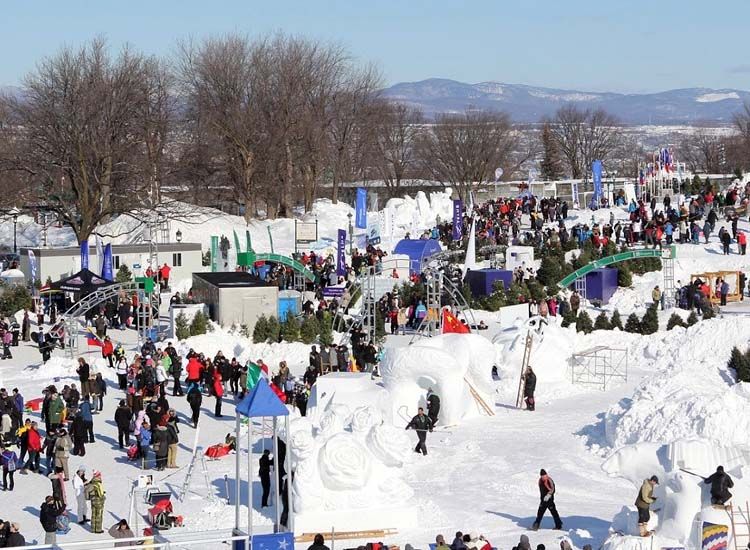
Jammu and Kashmir remain as the preferred choice of visitors traveling to India. What makes it more appealing is the Winter Carnival which adds to the fun and frolic offered by the state. Taking place at awe-inspiring locations like Nathatop and Patnitop, the popular winter festival offers umpteen memories to be cherished forever.
A number of sports festivals are conducted to keep the participants amused. Out of the many, skiing is the most cherished one. If you haven’t attended this fiesta yet, make sure that you become a part of the exciting event soon.
When it is celebrated – February or March
Where it is celebrated – Jammu and Kashmir
How it is celebrated – Various games, cultural activities, and events are held during the winter carnival. Besides these, a variety of celebrations keep the visitors engrossed. Folk songs and dance performances in traditional costumes are highlights of the merrymaking process.
They are a major part of festive celebrations. Snow sports and local delicacies tempt the guests to attend the fiesta again and again. Sledding, building snowmen, etc. are some of the activities which keep the participants energetic.
Konark Dance Festival – creating international brotherhood and cultural amity
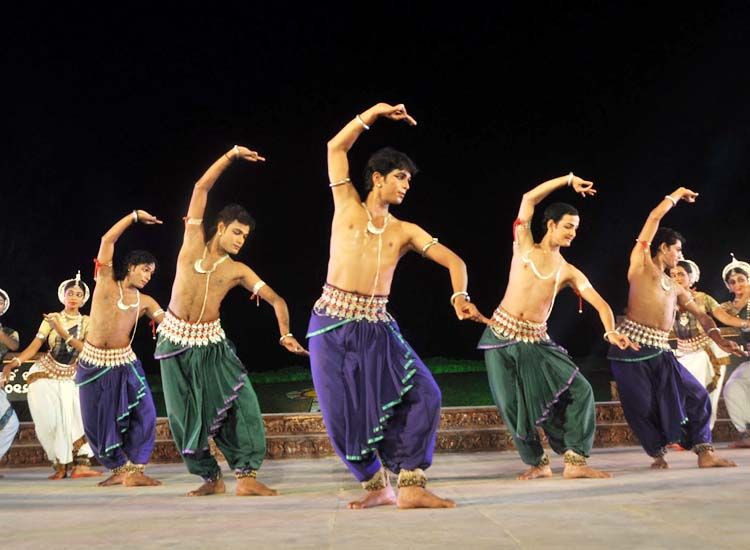
Konark Dance festival makes Odisha one of the best winter destinations in India. The fiesta has established its own unique identity. Outstanding national and international artists participate in the dance festival.
They feel privileged to perform Kathak, Odissi, Kuchipudi, Bharatnatyam, Mohiniattam, Manipuri, and another folk, classical & tribal dances/music of the country. The captivating stage of the Natyashala in the Sun Temple, Konark increases the festive spirit.
Considered one of the biggest dance festivals held in India, the event gives a golden chance to novice artists to get recognized on an international scale.
When it is celebrated – 1st – 5th December
Where it is celebrated – Sun Temple, Konark
How it is celebrated – Held at an Open Air Auditorium with a backdrop of Konark Sun temple, the five days dance festival presents a sight to behold. Daily, two different types of dances are performed which cover almost all types of Indian classical dances.
Tourists can choose to watch the programs from the viewing gallery as good arrangements are made for the same.
The sensuous body language, elegant gestures, and expressive faces of the dancers mesmerize the visitors.
During the festival, the entire Konark reverberates with the rhythms of the flute, ghungroo, and Pakhawaj. Don’t forget to visit the International Sand Art Festival at Chandrabhaga Beach.
Bihu Magh – Sankranti celebrations in Assam

Bihu Magh, another popular winter season festival in India is celebrated when the harvest season is over. The grand fiesta takes place amidst much fanfare in the state and among the Assamese people worldwide.
Obviously, when most of the chief festivals in Assam revolve around distinctive phases in the farming process, Bihu Magh is no exception. By this time, the granaries are abundant with fresh produce.
Availability is bountiful of food calls for some celebration without second thoughts. Good yield, cattle, and Earth, the mother Goddess are revered deeply during the festival. Bihu Magh is a joyride for all those who love feasting, festivals, and celebrations.
When it is celebrated – 15th January
Where it is celebrated – Assam
How it is celebrated – The day of Magh Bihu starts early with people cleaning their houses and wearing new attires. Useless pieces of stuff are thrown in the fire made from cow dung cakes. This epitomizes a new beginning.
Many people pay homage to Lord Indra, who according to Hindu mythology is “God of rains and clouds”. He is worshipped for good rains in the following months so that a good harvest is obtained.
Also, the natives make temporary huts from firewood and clay straw known as Mejis. Temporary makeshift accommodation is known as “belaghar” is also created around the Mejis. Families stay in the “belaghar” and stay awake all night to protect the Mejis.
Cultural programs and community feasts are observed throughout the night. People move out of their “belaghars” in the morning and after taking a bath in the river, burn their Mejis. The burnt pieces of Mejis are collected and sprinkled into fields, in order to get a good yield.
Conclusion
So many popular festivals in India in winter call for a big celebration throughout the season and cherish the time differently.
The above-mentioned blog describes some of the most popular winter festivals in India in winter. Explore these enthralling fairs and festivals in India that are celebrated with joy.



